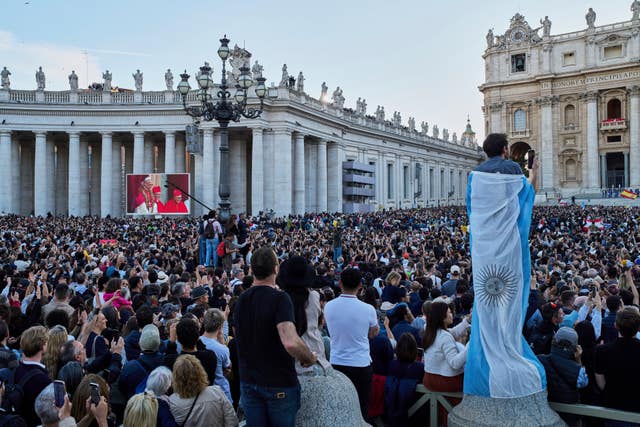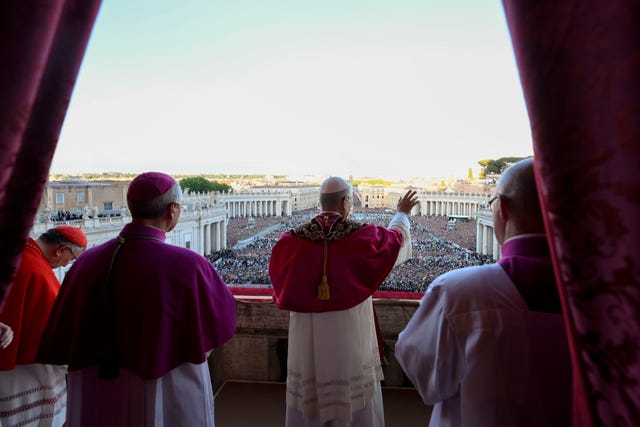Pope Leo XIV’s name choice ‘signals he will continue work of Francis’
Pope Leo will have the challenge of following in the footsteps of the late Francis, whose popularity saw him dubbed ‘the people’s pope’.

The new Pope’s choice of name signals he will continue the work of his predecessor, “institutionalising” Francis’s reforms, experts have said.
Pope Leo XIV, the first American head of the Catholic Church, emerged on to the balcony of St Peter’s Basilica in front of a packed St Peter’s Square on Thursday evening.
The election of the new Pope, formerly Cardinal Robert Prevost, from Chicago, was quickly hailed an honour and exciting time by US President Donald Trump.
Prime Minister Sir Keir Starmer described the election as a “deeply profound moment of joy for Catholics in the United Kingdom and globally”.
A Vatican spokesman confirmed Leo is a reference to Leo XIII – the last pontiff to have the name – who was head of the Catholic Church from 1878 to 1903.
Leo XIII laid the foundation for modern Catholic social thought, most famously with his 1891 encyclical Rerum Novarum, which addressed workers’ rights and capitalism at the dawn of the industrial age.
Leo could also refer to Brother Leo, the 13th century friar who was a great companion of St Francis of Assisi, it was claimed.
By choosing such a name, the new Pope could be signalling a strong continuity with Francis, who named himself after the saint.
Pope Leo will have the challenge of following in the footsteps of the late Francis, whose popularity saw him dubbed “the people’s pope”.
Dr Gonzalo Velasco Berenguer, lecturer in global medieval and early modern history at the University of Bristol, said: “I think one of the most interesting things about the election of the new Pope is his choice of name.

“At first glance it might not seem the most original choice, but it could be a symbol from the new Pope to continue the work of Francis.”
Professor Brandon Gallaher, from the University of Exeter, said Leo XIV will be a “Francis-like pontiff”.
“The new Pope Leo XIV is a continuity candidate to institutionalise Francis’s legacy in terms of linking it to the tradition of Catholic social teaching,” he continued.
“Leo XIV shares with Francis the desire to put the peripheries in the centre and care for migrants and those who are marginalised.
“He will be a Francis-like pontiff without the intense charisma of the late pope and with a better ability to unite the Catholic factions and greater attention to the canonical details of his decisions and likely greater discipline in terms of public statements.
“The choice of Pope Leo XIV shows that Pope Francis’s revolution in church life will now be institutionalised.”
The new Pope previously shared posts on social media that were critical of the Trump administration, including in February sharing an opinion piece from a Catholic newspaper which chastised US vice president JD Vance as wrong about some aspects of Christian teaching.

The secret conclave meeting had taken only around 24 hours to choose their new leader, giving the Church a pope less than three weeks after the death of his predecessor Francis.
Crowds had been joyously waving flags and chanting “Habemus Papam”, the Latin for “we have a Pope”, since white smoke rose from the Sistine Chapel shortly after 5pm UK time on Thursday.
The new pontiff is the 267th pope, becoming the religious leader of some 1.4 billion Catholics across the globe and someone believed to be called as the successor to St Peter, who was the first.
In his first words as Pope, the new pontiff told the adoring crowd: “Peace be with you.”
International development charity Cafod said Pope Leo “will be a voice of wisdom in a fractured and divided world”, and that his years as a missionary in Peru mean he can bring into his papacy “the vital perspective of the global south, elevating voices from the margins to centre stage”.
Three UK cardinals took part in conclave, Cardinal Vincent Nichols, Cardinal Timothy Radcliffe and Rome-based Cardinal Arthur Roche, as did Irish-born Cardinal Kevin Farrell, who has mainly ministered in the US and been based in Rome for some years.
Only those cardinals aged under 80 were eligible to cast a ballot, and this conclave was thought to be one of the most diverse ever, representing some 70 countries.
Pope Francis had appointed some 108 of the 133 cardinals who took part in the conclave to choose his successor.





